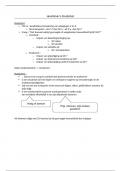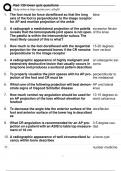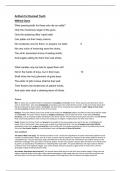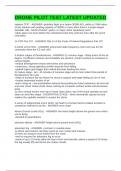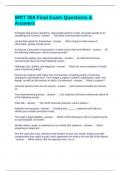UNIT 7 & 8: PART 5
TAXES AND PRICE CONTROLS
GOVERNMENT INTERVENTION IN COMPETITIVE MARKETS
- We’ve seen that when rational buyers and sellers
are free to make choices in their own interests in
competitive markets, the outcome is Pareto
efficient.
- It is impossible to make someone better off
without making someone else worse off.
- WTP = WTA → Total surplus is maximised.
- 𝑄𝑑 = 𝑄𝑆 → Buyers and sellers can execute their
decisions – there are no shortages or surpluses
- Government (or other) interventions that disturb the equilibrium so that the
quantity supplied is no longer where WTP = WTA will result in inefficiency.
- E.g. taxes and price controls
- In some cases, this can be justified:
o if it corrects another inefficiency elsewhere (e.g. public goods)
o if it results in a fairer outcome
TAXES:
Governments use taxes to:
- Finance government spending
- Redistribute resources
- Discourage “bad” behavior
Taxes
- Increase consumer prices
- Change buyers’ and sellers’ decisions
- Can generate deadweight loss
Taxes improve or reduce overall welfare depending on how the government spends the
revenue.
Do the taxes you pay increase or decrease your welfare?
USING TAXES TO RAISE REVENUE – SALT EXAMPLE:
- For most of history, humans have needed salt to survive and to preserve food.
- Rulers historically taxed salt to raise revenue because:
o demand is relatively inelastic.
o the tax is relatively easy to administer.
- In ancient Rome, soldiers’ salaries were paid in salt.
- Being “worth one’s salt” means to be deserving of one’s pay.
, SALT TAXES
The equilibrium price in the perfectly competitive market for salt is currently R10 per
kilogram. The government decides to levy a tax of R2 per kilogram. What will the new price
of salt be?
Not R12!
What we know is that the price buyers pay per kilogram will exceed the price sellers get by
R2 → a tax creates a price wedge equal to the size of the unit tax (tax amount per unit).
But taxes also affect incentives to buy and sell, so the market will have to readjust to a new
equilibrium, which affects prices and quantities.
The supply and demand model is useful for analyzing the effects of taxing salt.
- Initially the market equilibrium is at point A. The price is P* and the quantity of salt
sold is Q*
- Suppose the government imposes 30% tax ad valorem on salt:
o Supply with tax curve = MC*(1 + 30% tax)
o Changes the market equilibrium from A to B.
o At P1 and Q1
- The new competitive equilibrium:
o Increases the price paid by consumers from P* to P1 (by less than 30%)
o Reduces the price received by producers from P* to P0
o The market clears:
Qs at 𝑃0 =Qd at 𝑃1
o 𝑃1 – 𝑃0 is the tax paid to 10 government per unit of salt sold
TAXES AND PRICE CONTROLS
GOVERNMENT INTERVENTION IN COMPETITIVE MARKETS
- We’ve seen that when rational buyers and sellers
are free to make choices in their own interests in
competitive markets, the outcome is Pareto
efficient.
- It is impossible to make someone better off
without making someone else worse off.
- WTP = WTA → Total surplus is maximised.
- 𝑄𝑑 = 𝑄𝑆 → Buyers and sellers can execute their
decisions – there are no shortages or surpluses
- Government (or other) interventions that disturb the equilibrium so that the
quantity supplied is no longer where WTP = WTA will result in inefficiency.
- E.g. taxes and price controls
- In some cases, this can be justified:
o if it corrects another inefficiency elsewhere (e.g. public goods)
o if it results in a fairer outcome
TAXES:
Governments use taxes to:
- Finance government spending
- Redistribute resources
- Discourage “bad” behavior
Taxes
- Increase consumer prices
- Change buyers’ and sellers’ decisions
- Can generate deadweight loss
Taxes improve or reduce overall welfare depending on how the government spends the
revenue.
Do the taxes you pay increase or decrease your welfare?
USING TAXES TO RAISE REVENUE – SALT EXAMPLE:
- For most of history, humans have needed salt to survive and to preserve food.
- Rulers historically taxed salt to raise revenue because:
o demand is relatively inelastic.
o the tax is relatively easy to administer.
- In ancient Rome, soldiers’ salaries were paid in salt.
- Being “worth one’s salt” means to be deserving of one’s pay.
, SALT TAXES
The equilibrium price in the perfectly competitive market for salt is currently R10 per
kilogram. The government decides to levy a tax of R2 per kilogram. What will the new price
of salt be?
Not R12!
What we know is that the price buyers pay per kilogram will exceed the price sellers get by
R2 → a tax creates a price wedge equal to the size of the unit tax (tax amount per unit).
But taxes also affect incentives to buy and sell, so the market will have to readjust to a new
equilibrium, which affects prices and quantities.
The supply and demand model is useful for analyzing the effects of taxing salt.
- Initially the market equilibrium is at point A. The price is P* and the quantity of salt
sold is Q*
- Suppose the government imposes 30% tax ad valorem on salt:
o Supply with tax curve = MC*(1 + 30% tax)
o Changes the market equilibrium from A to B.
o At P1 and Q1
- The new competitive equilibrium:
o Increases the price paid by consumers from P* to P1 (by less than 30%)
o Reduces the price received by producers from P* to P0
o The market clears:
Qs at 𝑃0 =Qd at 𝑃1
o 𝑃1 – 𝑃0 is the tax paid to 10 government per unit of salt sold


